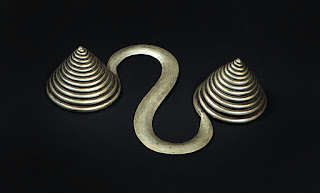 |
|
S-Shaped Counterweight, 20th Century
Miao or Dong culture; Guizhou, Hunan or Guangxi Province, China
Silver; 6 1/4 × 10 7/8 in.
2015.26.59
Anonymous Gift
|
Glance at the Moon
 |
|
Alternate image of 2015.26.59.
|
Silver was used as a currency in China as early as the turn of the common era. It is unclear when exactly the Dong and Miao of southern China began melting down standardized silver ingots to create adornments worn at festivals, but it has likely been at least since before the 14th Century. These crafted silver pieces are intricate and beautiful. Especially those of the Miao who are the most prolific silver makers of the region. This post examines Dong and Miao silver apron counterweights which fall outside of the norm for the region’s worn decorative silver objects by being the only instance of silver used for daily wear.
In Perfect Harmony
 |
|
Counterweight, 20th Century
Dong or Miao culture; Guizhou Province, China
Silver; 3 7/8 × 6 1/2 × 6 in.
2015.26.63
Anonymous Gift
|
The many silver ornaments owned by unmarried Dong and Miao women are worn at monthly festivals and celebrations like weddings. A standard costume includes a large headdress, earrings, necklaces, breast and shoulder ornaments, bracelets and more. Fully garbed, the adornments of a young woman can weight over 20 pounds. Though the Dong and Miao’s silver apron counterweight is a part of this festival wear, it also sees daily use, making it the only silver object always in Dong and Miao woman’s repertoire. There are a few standard forms of this counterweight, the most common of which is the S-shape. Knobbed forms are rarer, and could be used independently or in conjunction with the S-weight by wrapping one of the S-shaped weight’s curves around the perpendicular section connecting the knob and the W-shaped part of the knobbed weight. Either fiber or silver chains with silver coins used as buttons tie around the counterweight’s loops and connect to fabric ties on the back of aprons. Depending on the style, counterweights weigh between ½ to 1 ½ pounds with knobbed counterweights being the heaviest.
Silversmithing
 |
|
S-Shaped Counterweight, 20th Century
Miao culture; Guizhou Province, China
Silver; 5 1/4 × 3 13/16 × 1 3/8 in.
2015.26.82
Anonymous Gift
|
Unlike the ownership of silver which is carried down hereditarily from mothers to daughters, silversmithing has traditionally been performed by men and passed on from father to son. An immense degree of skill is required to craft silver, but due to the strains of agrarian life it was traditionally only done outside of the harvesting seasons. At least a dozen different techniques are used in the manufacture of silver ornaments. Chinese silver currency could be melted and either cast or forged into ornaments using molds. Advanced techniques such as knitting and engraving allow for intricate festival ornaments. Technological and economic developments in recent years have changed much of the manufacturing process. The final step of washing—repeated every few years to combat tarnishing due to oxidation—gives silver a brilliant sheen and is now done in a sodium borate bath. Recent economic pressures have also had many previously local silversmiths move into cities to find work. The cost of silver has led to a shift from pure silver to a cheaper alloy which is difficult to distinguish for the untrained eye.
Spirals in Silver
There is a lot of varying information on the importance of silver in Dong and Miao culture. Scholars agree that silver was first used as a ward against evil, but the explanation for this varies. Many pieces of festival wear are decorative reimagining’s of Han Chinese-style armor pieces, but this idea of protection is almost certainly embedded deeper in the objects’ medium and symbols. The interconnectedness of light, moon, fertility, and courtship are all agents in a complex symbolic meaning hinted at in Miao folk songs. Aesthetically speaking, the counterweights are simple objects, especially compared against most engraved silverwork ornaments. Only in the rarest cases do we sometimes see incised animal motifs along the curve of the S-shaped counterweight. The distinguishing motif for these weights is instead the spiral, which either as a flat or conical shape terminates the ends of these counterweights. This symbol dates to Neolithic Chinese pottery. Though its meaning in every day Miao life has become distanced from the ancient symbol, spirals originally represented the never-ending cycle of life. The yin-yang symbol on the weight’s knob also references the interconnected nature of being.
Text and images may be under copyright. Please contact Collection Department for permission to use. Information subject to change upon further research.


Comments